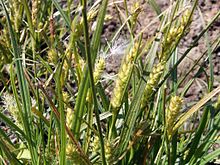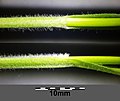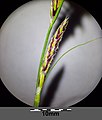Hairy sedge
| Hairy sedge | ||||||||||||
|---|---|---|---|---|---|---|---|---|---|---|---|---|

Female ears of hairy sedge ( Carex hirta ) |
||||||||||||
| Systematics | ||||||||||||
|
||||||||||||
| Scientific name | ||||||||||||
| Carex hirta | ||||||||||||
| L. |
The hairy sedge ( Carex hirta ), also known as the rough sedge , is a species of the sour grass family (Cyperaceae). It is one of the most common sour grasses and one of the few distinctly hairy sedge species.
description
The hairy sedge is a perennial, herbaceous plant that reaches heights of between about 5 to 60 centimeters. It is a deciduous geophyte that forms long underground runners during the growing season . The shoots are upright, bluntly triangular and leafed up to the top. At the base of the shoot it has some leaf sheaths that have no spiders , brown to purple-red in color, and when torn open, slightly reticulate . The flat, slightly runny green to gray-green leaves are scattered to woolly hairy, only rarely completely bare and about 3 to 6 millimeters wide. The edges of the leaf blades, which gradually narrow towards the tip, are rough. The ligule is flat-arched.
The hairy sedge is a variegated sedge . The inflorescence consists of three to nine sessile to long-stalked, upright spikes . The bracts of the inflorescence are leaf-like and usually longer than this. The hairy sedge has two to six ovate to short cylindrical female ears and above one to three slender cylindrical male ears. The multi-flowered female ears are 1 to 3 inches long and about 7 millimeters wide. They emerge from their bracts and are usually not distributed over entire stems. The male ears tower above the female and are up to 3 millimeters long and only 4 millimeters wide. The brown, green-keeled husks about 4 to 8 millimeters long narrow into a spiked tip. Male and female flowers each with three stamens (anthers) and three-branched ovaries. The yellow-green colored fruit sacs protrude diagonally and are 5 to 7 millimeters long and 2 millimeters wide. They narrow into a long, deep, two-toothed beak. The yellow-brown fruit is obovate and triangular. They are slightly inflated and often scattered to densely hairy.
The hairy sedge blooms from April to July.
Most of the time the entire plant is hairy, but the hairiness is often limited to individual areas, especially around the mouth of the leaf sheaths. Some authors call this form (fo. Hirtiformis (Pers.) Kunth ) the variety Carex hirta var. Hirtiformis (Pers.) Lej. understood.
The number of chromosomes is 2n = 112.
Distribution and location
The hairy sedge occurs throughout Europe with the exception of the extreme north, in North Africa and Asia Minor as far as Iran. It was introduced into North America and New Zealand ( neophyte ). It is common in Central Europe , but it is mostly absent in the low mountain ranges and the Alps above 1200 m. In the Allgäu Alps, it rises on the Lengenfeldalpe in Obertal east of the Nebelhorn in Bavaria up to 1400 m above sea level.
The hairy sedge prefers roadsides, creeks and embankments, but also colonizes meadows, gardens and wooded areas as well as gaps in wood. It also occurs on embankments in areas that are periodically flooded, because here it can spread rapidly with its foothills. It needs deep, loamy or sandy, base-rich and at least temporarily moist soil.
Socialization
According to Oberdorfer, the hairy sedge is a characteristic of the order of flood and wet pioneer lawns (Agrostietalia stolonifera) and of stepping plant communities (Plantaginetalia majoris). It also grows in semi- ruderal grasslands in dry and warm locations, in dry and semi -arid lawns and nutrient-rich herbaceous and perennial weeds .
ecology
Ecological pointer values according to Ellenberg : L - 7 T - 6 K - 3 F - 6 ~ R - XN - 5 S - 0
The plant is a semi-light plant, that is, it grows in full light, but tolerates shade within limits. It thrives best on fresh to moist soils, but can withstand strongly changing humidity conditions in its location very well. Its ecological focus is on soils with a moderate supply of nitrogen; it is less common on low-nitrogen and high-nitrogen locations. It is not salt-bearing and somewhat heat-loving.
As a deep-rooting and root-creeping pioneer , the hairy sedge makes a significant contribution to soil consolidation. Its runners can make it bothersome in gardens.
The hairy sedge is a perennial, runners-forming semi-rosette plant and a rhizome - geophyte . The hair on the plant serves as radiation protection.
The flowers of the hairy sedge are pollinated by the wind ( anemophilia ). The seeds are spread either by the wind ( anemochory ), by water ( hydrochory ), by self-propagation ( autochory ) or by the adhesive effect of the seeds ( epichory ), which can stick to animals.
Hazard and protection
The hairy sedge is not considered to be endangered worldwide and enjoys no separate legal protection.
Detail photos
swell
literature
- A. Petersen: The sour grasses. Akademie-Verlag, Berlin 1989, ISBN 3-05-500257-1 .
Individual evidence
- ↑ Jürke Grau , Bruno P. Kremer, Bodo M. Möseler, Gerhard Rambold, Dagmar Triebel: Grasses. Sweet grasses, sour grasses, rushes and grass-like families in Europe (= Steinbach's natural guide ). New, edit. Special edition edition. Mosaik, Munich 1996, ISBN 3-576-10702-9 .
- ↑ Hairy Sedge - Family Tree and Taxonomy . floraweb.de. Retrieved August 25, 2011.
- ↑ a b Erich Oberdorfer : Plant-sociological excursion flora for Germany and neighboring areas . With the collaboration of Angelika Schwabe and Theo Müller. 8th, heavily revised and expanded edition. Eugen Ulmer, Stuttgart (Hohenheim) 2001, ISBN 3-8001-3131-5 , pp. 193 .
- ↑ Rafaël Govaerts (ed.): Carex hirta. In: World Checklist of Selected Plant Families (WCSP) - The Board of Trustees of the Royal Botanic Gardens, Kew . Retrieved October 21, 2016.
- ↑ Erhard Dörr, Wolfgang Lippert : Flora of the Allgäu and its surroundings. Volume 1, IHW, Eching 2001, ISBN 3-930167-50-6 , p. 284.
- ↑ a b c Dietmar Aichele, Heinz-Werner Schwegler: The flowering plants of Central Europe . 2nd Edition. tape 5 : Swan flowers to duckweed plants . Franckh-Kosmos, Stuttgart 2000, ISBN 3-440-08048-X , p. 310 .
- ^ Heinz Ellenberg , HE Weber, R. Düll, V. Wirth, W. Werner, D. Paulißen: Pointer values of plants in Central Europe (= Scripta Geobotanica. 18). Erich Goltze, Göttingen 1992, ISBN 3-88452-518-2 .
- ↑ Erich Oberdorfer : Plant-sociological excursion flora . With the collaboration of Theo Müller. 7th, revised and expanded edition. Eugen Ulmer, Stuttgart (Hohenheim) 1994, ISBN 3-8252-1828-7 .
- ↑ Ruprecht Düll , Herfried Kutzelnigg : Pocket dictionary of the plants of Germany and neighboring countries. The most common Central European species in portrait . 7th, corrected and enlarged edition. Quelle & Meyer, Wiebelsheim 2011, ISBN 978-3-494-01424-1 , p. 194 .
- ↑ Hairy Sedge - Biological Characteristics . floraweb.de. Retrieved August 25, 2011.
Web links
- Hairy sedge. In: FloraWeb.de.
- Hairy sedge . In: BiolFlor, the database of biological-ecological characteristics of the flora of Germany.
- Profile and distribution map for Bavaria . In: Botanical Information Hub of Bavaria .
- Carex hirta L. In: Info Flora , the national data and information center for Swiss flora .
- Distribution in the northern hemisphere from: Eric Hultén, Magnus Fries: Atlas of North European vascular plants. 1986, ISBN 3-87429-263-0 at Den virtuella floran. (swed.)
- Thomas Meyer: Data sheet with identification key and photos at Flora-de: Flora von Deutschland (old name of the website: Flowers in Swabia )
Photos:










